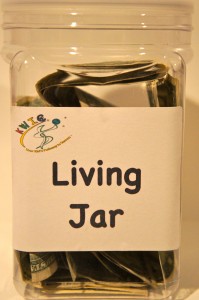Author Archive
From the Desk of Melanie Jane Nicolas – December 2012
The #1 Money Mistake Parents Pass On to Their Kids
http://youtu.be/xsLVFCRtxyY
Money Jars: The Kid-Proof System for Saving and Spending Money: Part 4
Money Jars: The Kid-Proof System for Saving and Spending Money: Part 4
“No act of kindness, however small, is ever wasted.”
-Aesop
The topic for today is giving. How do you teach your child to give cheerfully? Well that life lesson is made simple with the Donation Jar.
Dylan’s Story
When my son Dylan turned three years old, we had leftover cupcakes from his birthday party. He wanted more cupcakes than I would allow him to have. I thought this would be a great opportunity to teach him a life principle so I told him we’re giving the cupcakes away to the local shelter.
At first he was hesitant, but when I gave him the look like he didn’t have a choice, we drove over to the shelter. We walked into the shelter and had a whole tray of cupcakes. We walked around and gave one cupcake to every person in the building. Every person said “Oh, he’s so cute. Thank you so much; you just brightened up my day.” You could imagine what this did for my son’s self-esteem.
Wealth Principle
Contrary to popular belief, most wealthy people are very generous. You may have been taught that rich people are greedy and dishonest. However, there are greedy and dishonest people at all financial levels.
Why do the wealthy have so much? It’s because they’re utilizing a very important law. And that is the law of reciprocity, also known as the law of giving. Whatever you give out, is always returned back to you. Often times it’s even multiplied when it returns.
Teach your child young that giving is a routine part of managing money. When money flows freely through his or her hands, it comes back quickly and easily.
*Side Note: They shouldn’t give just for giving’s sake. They should genuinely feel good about it and want to give.*
Have them allocate 5% of his or her earnings for the Donation Jar.
With that experience from the shelter, Dylan learned that giving was not taking away something from him. Instead, it made him feel good to give. Ever since then, he loves taking money out of his Give Jar to donate or buy something for the local shelter in need.
Thank You for Reading Part IV of the Money Jar Series. Stayed Tuned for Part V.
Please join the conversation and let me know your thoughts below. Feel free to comment, share, and ask questions.
To You and Your Kids’ Wealth,
Melanie Jane
Related Articles:
Money Jars: The Kid-Proof System for Saving and Spending Money: Part I
Money Jars: The Kid-Proof System for Saving and Spending Money: Part II
Money Jars: The Kid-Proof System for Saving and Spending Money: Part III
Money Jars: The Kid-Proof System for Saving and Spending Money: Part V
Money Jars: The Kid-Proof System for Saving and Spending Money: Part VI
Money Jars: The Kid-Proof System for Saving and Spending Money: Part 3
Money Jars: The Kid-Proof System for Saving and Spending Money: Part 3
“If you wish to achieve worthwhile things in your personal and career life, you must become a worthwhile person in your own self-development.” –Brian Tracy
 Today we are discussing the 3rd Jar in the series which is the Education Jar. When I speak of education, I’m talking going beyond the traditional school and college system. Your child spends most of his or her childhood and young adulthood in the formal education system. That’s where he or she learns the basics. But what happens after college? Your child is taught to go get a “safe and secure” job. And typically the education stops.
Today we are discussing the 3rd Jar in the series which is the Education Jar. When I speak of education, I’m talking going beyond the traditional school and college system. Your child spends most of his or her childhood and young adulthood in the formal education system. That’s where he or she learns the basics. But what happens after college? Your child is taught to go get a “safe and secure” job. And typically the education stops.
Financial Success Secret
A wise man by the name of Steve Sipress once said, “A lifetime learner is a lifetime earner.” That implies that to be successful, you must continually educate yourself. We all know that education is an investment. You gladly pay for tuition, school fees, books, and supplies. Your kids will acquire technical skills and knowledge that will pay off in the long run in the form of a paying job or maybe even their own business. However, to enjoy continuous success and be a top performer, you must continue to invest in yourself via education.
What Does This Look Like?
Continuous education shows up in the form of seminars, trainings, conferences and retreats. They may be covering technical topics such as technology, sales and marketing. The sole purpose of the seminar may be to enhance your personal development also known as self-improvement.
When you teach your kids to use the education jar, you show them that not only is it okay, but they MUST Always Always Always invest in themselves. Because you are success-driven, you do things that may seem abnormal to the majority of people. When you tell a friend or family member about a conference they call you a “Seminar Junkie.” Or they say, “You’re going to ANOTHER conference?” This is a perfect example of the attitude or mentality that you DO NOT want to model for your children.
Continue to Learn & Grow
So you tell your kids, save 10% of everything you earn. Put that money in your Education Jar. This is for you to continuously invest in yourself and your education. Nothing is more important. If there’s a class you want to take or a new skill you want to learn, you use the funds allocated in this jar. ESPECIALLY in the field of money and financial success, your kids will constantly need to learn and grow. Coaches, live trainings, and home study systems are all part of the package. Sending your child to money camp is the perfect way to train them early for education beyond the classroom.
Right now your kids may want to take enrichment courses in music, language or art. They may want to go to dance class or get advanced training in a hobby like martial arts, hockey or gymnastics. Have them to contribute towards it with the money from the Education Jar.
Thank You for Reading Part III of the Money Jar Series. Stayed Tuned for Part IV.
Please join the conversation and let me know your thoughts below. Feel free to comment, share, and ask questions.
To You and Your Kids’ Wealth,
Melanie Jane
Related Articles:
Money Jars: The Kid-Proof System for Saving and Spending Money: Part I
Money Jars: The Kid-Proof System for Saving and Spending Money: Part II
Money Jars: The Kid-Proof System for Saving and Spending Money: Part IV
Money Jars: The Kid-Proof System for Saving and Spending Money: Part V
Money Jars: The Kid-Proof System for Saving and Spending Money: Part VI
Money Jars: The Kid-Proof System for Saving and Spending Money: Part 2
Money Jars: The Kid-Proof System for Saving and Spending Money: Part II
Welcome to Part II of our Money Management for Kids Series. Last time we discussed the 1st Jar, the Living Jar, and how it’s used for Living Expenses. Remember to have your child make a list of what he or she considers necessities and make an agreement that the money to purchase these items will come from the Living Jar.
Now it’s time to dive right in to the Jar #2.
The Savings Jar
The money allocated to the Savings Jar actually has two functions.
1. Emergency Money
AND
2. Long-Term Savings
This Jar is Amazing because it teaches your kids so many lessons! Because they must keep money on-hand for “emergencies,” you are teaching them to be prepared. We’re not talking have the kids pony up their cash when the pipes burst in the house. However, when there is an emergency in their world 🙂
- A wheel brakes on their skates and they have a hockey game the next day
- Their gaming system malfunctions and it needs repairs
- They received a bike for a gift. Now they need to buy all of the safety gear (helmet, knee pads and shoulder pads before they can ride it)
Do You Remember Dreaming of What Could Be?
As a child you drew pictures from your imagination and you told elaborate stories. Maybe you had a dream car that you always wanted. Or a dream place where you always wanted to travel.
When your child utilizes the Long-Term Savings function of the jar, they are learning how to Dream Build. More importantly, he or she is learning that any dream is possible. He can have anything he wants—with the right plan in place. She can buy that new bike; go on that special trip and even save up for her first car.
Here’s another lesson that your child is secretly learning—delayed gratification. We all know how important patience is when it comes to being good money manager. He or she will learn how to stop thinking in the “Right Now” and start planning for the Future. Goal-Setting is another bonus lesson. Your child is learning to set BIG GOALS and putting a financial plan in place to achieve them.
10% of your child’s money should be set aside for the Savings Jar. Then split that money in half—5% for emergencies and 5% for long-term savings.
This jar comes with a fun exercise as well. Have your children make a list of emergencies they should prepare for as well as a list of larger goals they want to achieve.
Thank You for Reading Part II of the Money Jar Series. Stayed Tuned for Part III. Please join the conversation and let me know your thoughts below. Feel free to comment, share, and ask questions.
To You and Your Kids’ Wealth,
Melanie Jane
Related Articles:
Money Jars: The Kid-Proof System for Spending and Saving Money: Part I
Money Jars: The Kid-Proof System for Saving and Spending Money: Part III
Money Jars: The Kid-Proof System for Saving and Spending Money: Part IV
Money Jars: The Kid-Proof System for Saving and Spending Money: Part V
Money Jars: The Kid-Proof System for Saving and Spending Money: Part VI
Money Jars: The Kid-Proof System for Saving and Spending Money: Part I
Welcome to Part I of the Money Jar Series. Over the course of this 6-part Series, I’m going to explain the core principles I teach my very own kids about money management. Use of the Money Jars is the basic foundation your kids need to be money smart and achieve financial success.
I absolutely LOVE the Money Jars. The system is simple, easy, and fun! There are 6 jobs of money, therefore 6 jars. Today we’ll start with the first jar—The Living Jar.
If you haven’t already guessed it, the Living Jar is for Living Expenses. Now you may be saying; my kids don’t have enough money to pay for their living expenses. What am I supposed to do? Start charging them for their share of the utilities, food, and rent?
Well, if your kids are under the age of 18, that may be a little harsh and maybe borderline illegal :). So don’t go off writing up a lease and tagging the food in the refrigerator just yet. However, this IS a good time to sit down with your kids and have a talk about wants versus needs.
Let’s be honest. Many of the things our kids want aren’t necessarily what they need. So instead of constantly swiping the bank card for little trinkets, gadgets, and treats here and there, let your child take some responsibility of purchasing some of these things himself.
Make A List
To start using the Living Jar, have your children make a list of all things they like to buy, but can live without. Some examples are:
- Candy
- Movie Rentals
- Video Games
- Hair Accessories
Make An Agreement
Once they’ve completed the list, make an agreement with your kids that from now on, items on that list come out of The Living Jar Money.
As a general rule of thumb, 55% of all your kids’ money should be allocated to the Living Jar. So everytime your child receives an allowance, gifts, a paycheck, or revenue from his or her own business, 55% of the money automatically goes towards living expenses.
I love this exercise because it teaches kids how to be more responsible with their money. Trust me, once you implement the Living Jar and attach it to the list of expenses, your kids will think twice about every purchase they make. They will seriously consider whether or not they want or need it, and ultimately, if they should buy it.
I hope you’ve enjoyed Part I of the Money Jar Series. I look forward to sharing Part II with you soon. Please join the conversation and let me know your thoughts below. Feel free to comment, share, and ask questions.
To You and Your Kids’ Wealth,
Melanie Jane
Related Articles:
Money Jars: The Kid-Proof System for Saving and Spending Money: Part II
Money Jars: The Kid-Proof System for Saving and Spending Money: Part III
Money Jars: The Kid-Proof System for Saving and Spending Money: Part IV
Money Jars: The Kid-Proof System for Saving and Spending Money: Part V
Money Jars: The Kid-Proof System for Saving and Spending Money: Part VI
Money Management For Kids—The Basics
What usually happens when you give your child money? If you’re like a majority of parents, your answer is something like:
- They Spend All of It and Don’t Save a Dime
OR
- It’s Gone So Fast
I know it seems like they always have their hand out asking for the latest toys and gadgets. Wiis, iPods, iPads, and Kindles just to name a few.
Yes you want to give your child and everything they’ll ever want. Yet you also don’t want them to be selfish, spoiled brats. So where do you draw the line?
Well I have a system that I use to teach my own kids how to manage their money. Whatever their want or need, if they follow this system, (which I call kid-proof), they’ll ALWAYS have enough money to get the things that they desire.
Where Do You Begin?
First you start out by telling your children that there are 6 jobs of money. OR that money has 6 different functions to perform. So that means there are 6 different categories by which they will allocate their money.
Where Did This Come From?
I learned these money management principles at a seminar called Millionaire Mind Intensive by T. Harv Eker’s Peak Potentials. (Shout out to Harv if you ever read this!:)) Anyways, it was so easy and simple—I immediately fell in love with the concepts and have been teaching it to my kids ever since.
Ok Let’s Begin Shall We?………………….
Just Kidding……..
If I talked about all 6 jobs of money right now you’d probably
a) Click off This Page
b) Attempt to Read with Eyes Glazed Over
c) Actually Read It & Not Retain A Word I Say
So I did you a favor and turned this topic into a 6-part blog series that I’ll be sending you in the next few weeks titled “Money Jars: The Kid-Proof System for Spending and Saving Money”
Stay tuned for Part I of the Series.
To You and Your Kids Wealth,
Melanie Jane
From the Desk of Melanie Jane Nicolas – September 2012
Labor Day, according to Wikipedia, is an American federal holiday observed on the first Monday in September that celebrates the economic and social contributions of workers. I remember in my nursing days when I looked forward to Labor Day because of a well-deserved day off. However, it didn’t take me long to realize that I can create my own days off as an entrepreneur. With continuous education and discipline in my work habits, I learned that I can create my own economy.
After “retiring” from my nursing career over 6 years ago, I’ve recently met with some of my previous co-workers who are now laid off or in fear of being laid off from their nursing jobs. Who would’ve thought that a shortage of nurses back then would lead to an abundance of nurses being laid off? My mom, in particular, was one of them. After working for a company for over 30 years, this hospital decided to give my mom’s position away 3 months before she was to retire. With continuous calls to the President of the hospital, the hospital gave her a leave of absence that allowed her to reach full retirement. At the end of her service, she received a nice pen:)
My mom was fortunate that she had people in her family that was in the medical field to insure her full retirement. She is now in the Philippines enjoying her life. It’s amazing to me that she had in her mind that she had to wait until she was 66 years old to enjoy life. This is a common practice for many. With the job loss of so many, I want to stress the importance of creating your own economy.
Having said this, here are 3 Steps to Creating Your Own Economy:
- Change Your Focus: Beginning immediately, stop talking about anything that is not working. Stop defending and justifying why you’re not doing better. Stop blaming the economy or whatever else you deem to be the cause of your troubles. If something is not working, continuing to talk about it will cause you to start seeing more things going wrong and continue the downward spiral.?Ask only, “What’s working?” What you focus on, grows. And that’s why it’s important to be mindful of what you are focusing on.
- Mine the Gold That’s Already in Your Business: Every business has “hidden” opportunities which can be mined, usually by either developing new markets for your products, creating new products, leveraging the relationships you’ve built, and joint venturing with colleagues, suppliers, customers and, yes, even competitors. Don’t get the “shiny object syndrome” in which you want to do so many new things and finish none.
- Develop Systems and Follow Through: The best way to do this is to hire a business coach or appoint someone in your organization to be your team’s “accountability partner” to ensure your renewed vision is being carried out and that you are steadily moving in the right direction. Many business owners think that they’ll hire a coach when they make more money. It is actually the opposite. You hire a business coach to make more money.
As always, the sooner you instill and model an entrepreneurial mindset utilizing these steps, the sooner you can create your own Labor Day. Avoid the practice of living and enjoying life when you “retire”. I hope you enjoyed your Labor Day weekend!
From the Desk of Melanie Jane Nicolas – August 2012
Last month was one of the most powerful breakthroughs Kids Wealth International Club has experienced. With our Ribbon Cutting with Mayor Pradel in Naperville and the expansion of our new KWIC Minds, our company is significantly growing. I’d like to say that when running a success culture company with a vision which my KWIC Team shares, that stars align and everything goes smoothly. I mean, who doesn’t want to empower kids to a healthier financial future? 🙂 And with my passion to teach kids about finances and entrepreneurship, all “should” go well. However, as most of you may know, running a business isn’t that easy.
What matters most is your WHY. Most people don’t succeed because they don’t have a big enough why. So when the challenges arrive, they give up so easily. Or even worse, they give up when their company is about to reach exponential growth. It takes time to cultivate a success culture. It takes diligence to implement the things needed to monetize a business. And it takes the right organized knowledge to implement. You have probably heard the saying “practice makes perfect.” It is actually “perfect practice makes perfect.”
As I’ve watched the Olympics this past week, I wonder what those competitors are thinking to themselves. They, too, have their why and their passion and love of the game. They, too, have coaches like me to push them to grow, keep them accountable, and be successful. They, too, are diligent in their perfect practice. They, too, implement with calculated risks. They, too, take opportunities when they see them. It takes a winner to be in the Olympics. And that’s what our KWIC Kids are…WINNERS! They have played full out in our KWIC Money Camp to learn and better themselves. They are practicing the financial skills they have learned to be better managers of their money and financially responsible. They took the opportunity to go on our bank tour during our camp. Hence, they were prepared and rewarded with the opportunity to hold one of the 1996 Olympic torches held by the President of Naperville Bank and Trust, Tom Miers, who just happen to bring the torch into the bank that day. What are the chances for these KWIC Kids to be at the right place at the right time!?!
Now, I just didn’t learn all of these wealth principles overnight. I started mentoring with experts in finances and business over 10 years ago. So as I was teaching the KWIC Money Camps this past month, I have am certain that those KWIC kids’ lives have changed forever. People ask, “Aside from how to make, manage, and multiply money, what else do the kids learn?” Here are the Top 5 Values your kids will learn in our KWIC Camps:
1. Self-esteem: Studies show that 80% of your child’s belief system is established by age 8. By teaching kids about wInner beliefs, the kids understand how to build self-confidence and inner wealth. This is how my daughter Jardel was inspired to write her own book at age 7, “My wInner Self: How to be a winner from the inside out.”
2. Leadership skills: Stedman Graham focuses on identity, and his first step of finding your identity is Leadership. Kids Wealth International Club is focused on creating leaders of children so that others will not identify who they are for them and put them in a “box”.
3. Teamwork: Kids these days are so competitive. They are taught in school that helping each other is “cheating”. We teach kids how to rise people up because with a Team, Together Everyone Achieves Miracles.
4. Relationships: The quality of your life is directly proportionate to the quality of your relationships and the commitments you keep within your relationships…especially your relationship to yourself.
5. Fun: Kids Wealth International Club’s tag line is “Helping your kids get rich in a fun way.” When I say rich, it encompasses all aspects of wealth. When I say fun, our KWIC Team understands that your kids learn best when they are experiencing fun. Most financial literacy programs don’t understand this, and I’ve watched teachers struggle to keep the kids’ attention and retention. We don’t have this problem at our KWIC Camps.
Take these principles and apply them into your own lives and your kid’s lives.
Check out our new KWIC Minds, where your kids go out into the real world and apply the concepts learned from our KWIC Camps. You as the parents will also learn more on raising wealthy kids through our webinars. Click HERE.
From the Desk of Melanie Jane Nicolas – July 2012
Happy 4th of July to you and your family!
This month is always special to me not only because of all the fun I have with my family, but because it is a reminder of how blessed we are to have this freedom. To think, we often take for granted that we are in America and we are given the freedom and benefits that most countries don’t have. Some worked hard to come and live in this great land of liberty, and others have this freedom because they were born here.
I, myself, was born in the United States. However, when I was 2 years old, my parents visited the Philippines, and my brother and I ended up living there for 5 years. I am blessed to have been exposed to our culture because I am reminded of how grateful I need to be for what I have here in America.
For instance, I remember eating at Jollibee (the Filipino McDonald’s) with my mom when I was 4 years old. There would be a group of homeless kids gathered at the window staring at the food we were eating. I asked my mom, “How come they don’t have any food to eat?” My mom would reply, “Because there are a lot of kids here who have no means of having a meal because their parents have no money.” I felt bad for those kids and remember asking my mom if I can share my food.
My mom, who is nurturing, would buy a bunch of burgers and distribute them to all the kids. She is an amazing role model, and she had taught me the value of generosity. No wonder why I’m always feeding others even 32 years later 🙂 She would say to me, “When it comes to food…there is always enough for everyone.” Food is never wasted in our home.
So living in America we have many freedoms…the freedom of religion, freedom of speech, freedom of the press, freedom of assembly, freedom of petition, and so forth.
What I’d like to talk about is Financial Freedom. Why is it that some people lack financial freedom, and to others, financial freedom comes so easily? Is it because some people were born in certain circumstances? Or maybe some people are just lucky? It is neither of these.
I have met many millionaires who started off with just a few dollars in their pockets and whose parents didn’t have much. There are also those people who are “lucky” winning the lottery and then filing bankruptcy a couple of years later. I believe it is the inner beliefs we have about money, the habits we have around money, and our ability to manage money. So when I talk about inner beliefs, do you have an abundant mindset or a limited mindset? Do you say to your kids “we can’t afford it” (limited mindset) or “how can we afford it?” (which opens your mind to the abundance the world has to offer).
When it comes to habits, do you actually have a system (such as the one in my FREE report “The #1 Secret to Your Kid’s Financial Success”) to allocate your funds? Or do you just go about your month living paycheck to paycheck and not knowing where your money is going? How does financial freedom look like to you? Here is my definition of financial freedom.
Financial Freedom is when your passive income is greater than the cost of your CHOSEN lifestyle. I say chosen because there are many people who make 7 figures and are drowning in debt. While others who understand this concept, earn less money and are financially free. They know how to create wealth by investing in the 3 Pillars of Wealth (business, real estate, and stocks) that give them passive income (where you do the work once and earn income over and over and over again).
So choose a lifestyle that will allow you to reach financial freedom! With all the freedoms we have here in America, why not Financial Freedom?
Be safe on the 4th of July, and be grateful for what you have!
From the Desk of Melanie Jane Nicolas – June 2012
As we go into the summer, I’m sure that many of you are busy preparing for your kids’ activities, vacations, and family outings. It is very easy to get caught up in the doing and less in the enjoying. I know that I myself have this problem, having four little ones to take care of and a business to run. This is where I need to take the leadership role not only with my kids, but with myself. Here are some things I do to keep sane 🙂
1. Work smarter – Don’t start every project from scratch. In my business, I’ve developed standardized forms and steps, called systems, so that once a project is done, it is duplicatable. For example, as you noticed, you receive a monthly KWIC Newsletter every first Monday of each month which has already been created once and all I need to do is write my special letter to you to plug into the pre-formatted header.
2. Debrief your activities – Take the time after each activity or project your staff organizes to talk about how it went before jumping into the next project. Lead a discussion based on three questions: What happened? So what? Now what?
3. Do less – People always ask me how I get so much done. Answer: I delegate. Think about how much your time is worth. Having four kids, I would rather spend my precious time with them than do things I don’t like doing. So I hired a house manager who takes care of the every day activities that I would otherwise be doing without her ie. laundry, dishes, cleaning, etc…
4. Collaborate more – How can you collaborate more with other groups in your community to have a bigger impact? Is there a way to involve some of these groups in some of the activities you have going on? Collaboration is a great way to enjoy more.
5. Get organized – I once heard that people spend 20% of their time looking for things. Can you imagine wasting this much of your life? Take some time to reorganize your computer, email, files, calendar, and storage closet. It may take a huge effort when doing this, but imagine all the time you’ll save in the immediate future.
6. Put technology to work for you – I can honestly say that I am not technologically savvy. However, I do know the basics, and I hire people who are great at programs and digital tools that will make my life easier for me.
7. Improve communication – Look for ways to improve the way you communicate with your staff and family members. We often run into difficulty with people because they don’t know something, so you can head off problems by keeping them informed. The quality of your relationships is directly proportionate to your ability to communicate effectively with people.
8. Stay away from negative people – Cultivate the friendship of positive people and keep clear of people who always have a negative approach to things. Negative people have a way of pulling everyone else down with them.
9. Lose weight – Instead of the typical resolution to start dieting, consider what issues or problems are weighing you down. A person typically has 15-17 messes in their lives. It may be a mess in a relationship, a mess in the trunk of their car, or a mess with their taxes. Make a list of these messes and determine which mess you want to tackle for the month. Get some people together to help you come up with a solution and implement it. You’ll feel less stressed with that mental weight off your mind.
10. Set the stage for the summer – Plan ahead of time how your summer will look like. I personally do this by having a huge calendar with all the activities and work days scheduled so that my entire family and staff can see them. This way, everyone is on the same page which causes less confusion and overwhelm.
11. End the school year on a solid financial footing – Check your family and business budget to see if your revenues and expenses are as planned. For more information on how to do this, come to one of our KWIC Mini-Camps www.kwickids.com/camps/
12. Network – Build great relationships with like-minded people. They will help you keep going when your motivation is dwindling or you need some new ideas regarding family or business.
I hope these leadership tools will help you enjoy your summer to it’s fullest!





